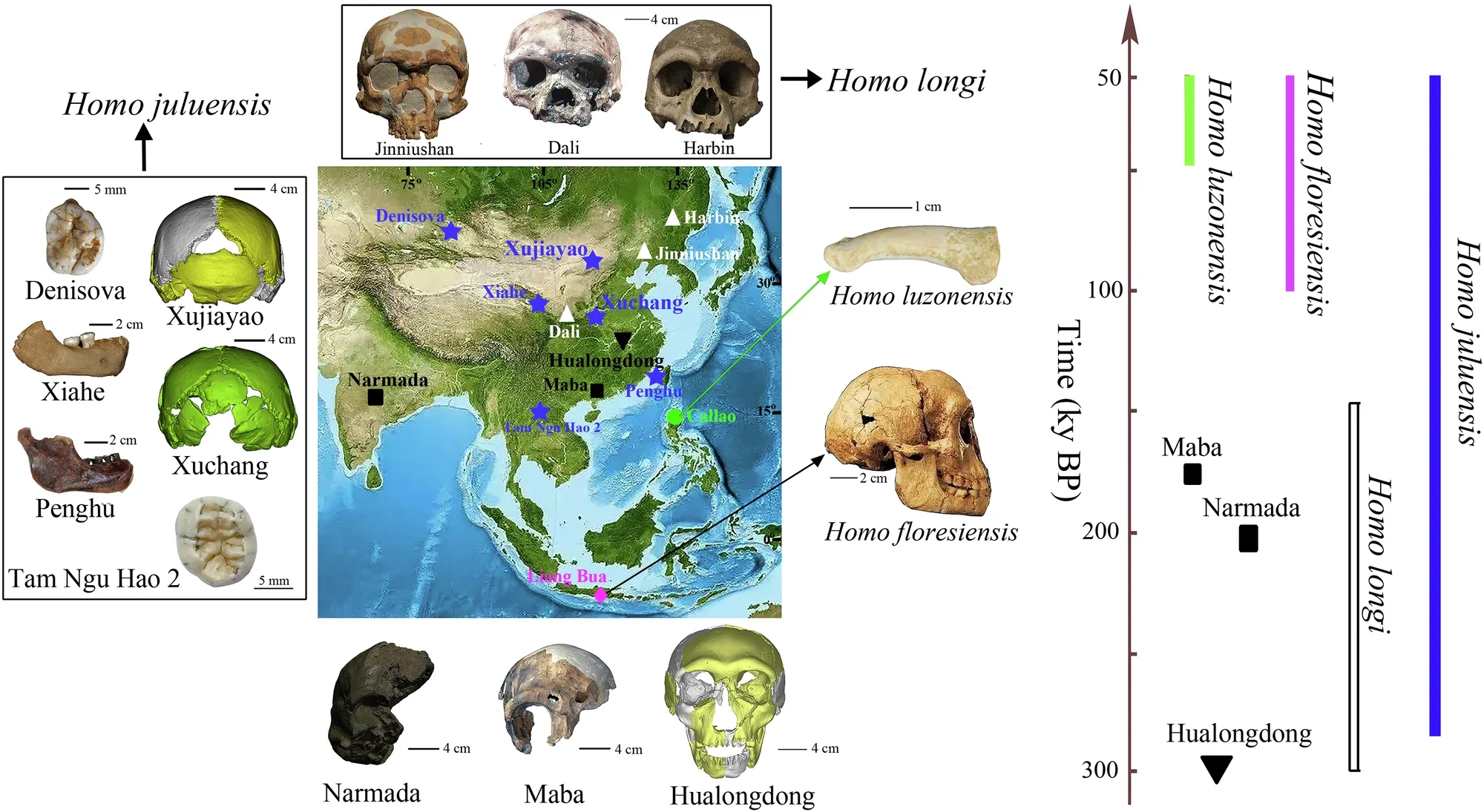The story of human evolution is more intricate than ever, especially in eastern Asia during the Late Quaternary period, approximately 300,000 to 50,000 years ago.
Recent fossil discoveries are reshaping our understanding of ancient hominins, their diversity, and their interactions. Fossil finds such as Homo floresiensis, H. luzonensis, H. longi, and H. juluensis highlight how new perspectives are unraveling complexities in the human evolutionary tree.
For decades, researchers lumped eastern Asian hominin fossils into broad categories such as Homo erectus or early Homo sapiens. This conservative approach stemmed from a mid-20th-century push to avoid over-classifying fossils.
Early paleoanthropology, particularly after the Cold Spring Harbor Symposium in 1950, discouraged assigning fossils to new species without clear distinctions. The aim was to emphasize shared traits rather than differences, but this inadvertently masked the region’s profound morphological diversity.

Eastern Asia’s Late Quaternary fossil record defies earlier models of human evolution. Traditionally, two theories dominated: the “Multiregional Evolution” model, which proposed regional continuity with gene flow between populations, and the “Out of Africa” model, which argued for a complete replacement of indigenous populations by African-origin modern humans.
Current evidence suggests a blend of these models. Multiple waves of migrations from Africa likely mixed with indigenous populations, resulting in complex evolutionary scenarios.
One breakthrough was the identification of Homo floresiensis in 2004 on Indonesia’s Flores Island. Dubbed the “Hobbit” for its small stature, this species demonstrated that isolated island populations could follow unique evolutionary paths.
Similarly, the 2019 discovery of Homo luzonensis on Luzon Island in the Philippines revealed another diminutive species with distinct traits, such as curved toe bones that hint at tree-climbing adaptations.
Related Stories
In China, the narrative shifted further with Homo longi, introduced in 2021 after studying the Harbin skull. This large cranium bore characteristics distinct from Homo erectus or Homo sapiens, hinting at a complex lineage. Fossils like those from Dali and Jinniushan may also belong to this group, pending further analysis.
The most recent addition, Homo juluensis, emerged through a detailed examination of fossils like the Xujiayao skull and Xuchang crania. This new species is proposed to include the enigmatic Denisovans—ancestors known primarily from DNA rather than fossil evidence. The Denisovan link is bolstered by similarities in jaw and tooth morphology across sites in Siberia, Tibet, and Laos.
Professor Christopher J. Bae, from the University of Hawaiʻi at Mānoa, has been pivotal in uncovering this evolutionary puzzle. With over 30 years of research across Asia, Bae and his collaborators developed a systematic framework for categorizing fossils, akin to organizing a complex family photo album.
“This study clarifies a hominin fossil record that has tended to include anything that cannot easily be assigned to Homo erectus, Homo neanderthalensis, or Homo sapiens,” Bae explained.

Such advancements are not limited to taxonomy. The Hualongdong fossils from central-eastern China illustrate the mosaic nature of human evolution. Dating back 300,000 years, these remains display a mix of traits, aligning with neither Homo juluensis nor Homo longi, underscoring the complexity of defining rigid species boundaries.
Eastern Asia’s fossil record also challenges evolutionary unilinearity. Fossils from sites like Maba in southeastern China and Narmada in India exhibit overlapping characteristics with Neanderthals and other hominins. These specimens remain unclassified but highlight how diverse populations coexisted and intermingled.
The region’s richness contrasts with Europe and Africa, where only one new Late Quaternary species, Homo naledi, has been proposed in recent years. This disparity reflects an increase in research initiatives and discoveries in Asia, leading to better understanding and appreciation of the region’s evolutionary landscape.
Homo juluensis, for instance, thrived in eastern Asia until about 50,000 years ago. These ancient humans likely hunted wild horses, crafted stone tools, and processed animal hides for survival. Their interactions with other hominins, such as modern humans and Neanderthals, shaped the genetic and cultural tapestry of the region.

Despite these advances, many questions remain. Could fossils like those from Maba and Narmada belong to known species, or do they represent entirely new groups? How did these populations adapt to their environments and interact with one another? Ongoing research is vital for resolving these mysteries.
Eastern Asia’s hominin record exemplifies the complexity of human evolution. It demonstrates how models like multiregionalism or the Out of Africa hypothesis must adapt to accommodate new data. These discoveries are not just about categorizing fossils; they reshape our understanding of humanity’s shared history.
Note: Materials provided above by The Brighter Side of News. Content may be edited for style and length.
Like these kind of feel good stories? Get The Brighter Side of News’ newsletter.
The post Scientists discovered a new human species that is rewriting human history appeared first on The Brighter Side of News.